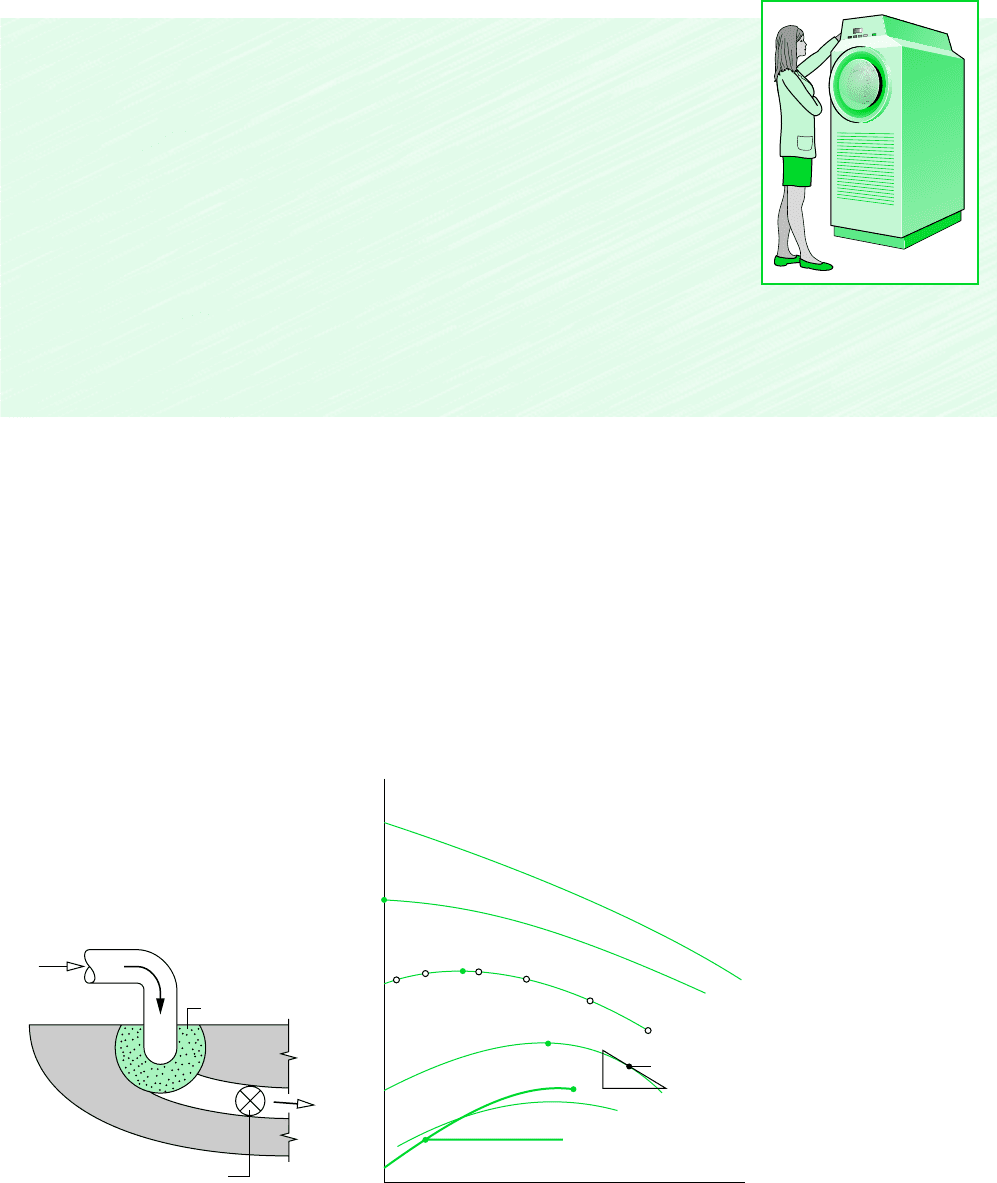Moran M.J., Shapiro H.N. Fundamentals of Engineering Thermodynamics
Подождите немного. Документ загружается.


516 Chapter 11 Thermodynamic Relations
In developing this result, the relationship between partial derivatives expressed by Eq. 11.15
has been used.
Several important conclusions about the specific heats c
p
and c
v
can be drawn from
Eq. 11.69. for example. . . since the factor
2
cannot be negative and is positive
for all substances in all phases, the value of c
p
is always greater than, or equal to, c
v
.
The specific heats would be equal when 0, as occurs in the case of water at 1 atmos-
phere and 4C, where water is at its state of maximum density. The two specific heats also
become equal as the temperature approaches absolute zero. For some liquids and solids at
certain states, c
p
and c
v
differ only slightly. For this reason, tables often give the specific heat
of a liquid or solid without specifying whether it is c
p
or c
v
. The data reported are normally
c
p
values, since these are more easily determined for liquids and solids.
EVALUATING c
p
兾c
v
. Next, let us obtain expressions for the ratio of specific heats. Em-
ploying Eq. 11.16, we can rewrite Eqs. 11.46 and 11.55, respectively, as
Forming the ratio of these equations gives
(11.70)
Since ( s p)
T
1( p s)
T
and ( p T )
s
1( T p)
s
, Eq. 11.70 can be expressed as
(11.71)
Finally, the chain rule from calculus allows us to write ( v p)
T
( v s)
T
( s p)
T
and
( p v)
s
( p T )
s
( T v)
s
, so Eq. 11.71 becomes
(11.72)
This can be expressed alternatively in terms of the isothermal and isentropic compressibilities as
(11.73)
Solving Eq. 11.72 for ( )
s
and substituting the resulting expression into Eq. 9.36b
gives the following relationship involving the velocity of sound c and the specific heat ratio k
(11.74)
Equation 11.74 can be used to determine c knowing the specific heat ratio and p–v–T data,
or to evaluate k knowing c and ( p v)
T
. for example. . . in the special case of an
ideal gas, Eq. 11.74 reduces to
(9.37)
as can easily be verified.
In the next example we illustrate the use of specific heat relations introduced above.
c 1kRT
1ideal gas2
00
c 2kv
2
10p
0v2
T
0p
0v
k
k
a
k
c
p
c
v
a
0v
0p
b
T
a
0p
0v
b
s
000000
000000
c
p
c
v
ca
0v
0s
b
T
a
0s
0p
b
T
dca
0p
0T
b
s
a
0T
0v
b
s
d
00000000
c
p
c
v
10v
0s2
T
10T
0v2
s
10p
0s2
T
10T
0p2
s
c
p
T
a
0s
0T
b
p
1
10p
0s2
T
10T
0p2
s
c
v
T
a
0s
0T
b
v
1
10v
0s2
T
10T
0v2
s

11.5 Other Thermodynamic Relations 517
EXAMPLE 11.6 Using Specific Heat Relations
For liquid water at 1 atm and 20C, estimate (a) the percent error in c
v
that would result if it were assumed that c
p
c
v
,
(b) the velocity of sound, in m/s.
SOLUTION
Known: The system consists of a fixed amount of liquid water at 1 atm and 20C.
Find: Estimate the percent error in c
v
that would result if c
v
were approximated by c
p
, and the velocity of sound,
in m/s.
Analysis:
(a) Equation 11.69 gives the difference between c
p
and c
v
. Table 11.2 provides the required values for the volume expansiv-
ity , the isothermal compressibility , and the specific volume. Thus
Interpolating in Table A-19 at 20C gives c
p
4.188 Thus, the value of c
v
is
Using these values, the percent error in approximating c
v
by c
p
is
(b) The velocity of sound at this state can be determined using Eq. 11.65. The required value for the isentropic compressibility
is calculable in terms of the specific heat ratio k and the isothermal compressibility . With Eq. 11.73, k. Inserting
this into Eq. 11.65 results in the following expression for the velocity of sound
The values of v and required by this expression are the same as used in part (a). Also, with the values of c
p
and c
v
from
part (a), the specific heat ratio is k 1.006. Accordingly
Consistent with the discussion of Sec. 3.3.6, we take c
p
at 1 atm and 20C as the saturated liquid value at 20C.
The result of part (a) shows that for liquid water at the given state, c
p
and c
v
are closely equal.
For comparison, the velocity of sound in air at 1 atm, 20C is about 343 m/s, which can be checked using Eq. 9.37.
c
B
11.0062110
6
2 bar
1998.21 kg/m
3
2 145.902
`
10
5
N/m
2
1 bar
``
1 kg
#
m/s
2
1 N
`
1482 m/s
c
A
kv
k
a
c
p
c
v
c
v
b 11002 a
0.027
4.161
b 11002 0.6%
c
v
4.188 0.027 4.161 kJ/kg
#
K
kJ/kg
#
K.
0.027
kJ
kg
#
K
a272.96 10
6
bar
#
m
3
kg
#
K
b `
10
5
N/m
2
1 bar
``
1 kJ
10
3
N
#
m
`
a
1
998.21 kg/m
3
b 1293 K2 a
206.6 10
6
K
b
2
a
bar
45.90 10
6
b
c
p
c
v
v
Tb
2
k
❶
❷
❸
❶
❷
❸

11.5.3 Joule–Thomson Coefficient
The value of the specific heat c
p
can be determined from p–v–T data and the Joule–Thomson
coefficient. The Joule–Thomson coefficient
J
is defined as
(11.75)
Like other partial differential coefficients introduced in this section, the Joule–Thomson co-
efficient is defined in terms of thermodynamic properties only and thus is itself a property.
The units of
J
are those of temperature divided by pressure.
A relationship between the specific heat c
p
and the Joule–Thomson coefficient
J
can be
established by using Eq. 11.16 to write
The first factor in this expression is the Joule–Thomson coefficient and the third is c
p
. Thus
With ( )
T
1()
T
from Eq. 11.15, this can be written as
(11.76)
The partial derivative ( )
T
, called the constant-temperature coefficient, can be eliminated
from Eq. 11.76 by use of Eq. 11.56. The following expression results:
(11.77)
Equation 11.77 allows the value of c
p
at a state to be determined using p–v–T data and the
value of the Joule–Thomson coefficient at that state. Let us consider next how the
Joule–Thomson coefficient can be found experimentally.
EXPERIMENTAL EVALUATION. The Joule–Thomson coefficient can be evaluated experi-
mentally using an apparatus like that pictured in Fig. 11.3. Consider first Fig. 11.3a, which
shows a porous plug through which a gas (or liquid) may pass. During operation at steady
state, the gas enters the apparatus at a specified temperature T
1
and pressure p
1
and expands
through the plug to a lower pressure p
2
, which is controlled by an outlet valve. The temper-
ature T
2
at the exit is measured. The apparatus is designed so that the gas undergoes a
throttling process (Sec. 4.3) as it expands from 1 to 2. Accordingly, the exit state fixed by
p
2
and T
2
has the same value for the specific enthalpy as at the inlet, h
2
h
1
. By progres-
sively lowering the outlet pressure, a finite sequence of such exit states can be visited, as in-
dicated on Fig. 11.3b. A curve may be drawn through the set of data points. Such a curve is
called an isenthalpic (constant enthalpy) curve. An isenthalpic curve is the locus of all points
representing equilibrium states of the same specific enthalpy.
The slope of an isenthalpic curve at any state is the Joule–Thomson coefficient at that state.
The slope may be positive, negative, or zero in value. States where the coefficient has a zero
value are called inversion states. Notice that not all lines of constant h have an inversion state.
The uppermost curve of Fig. 11.3b, for example, always has a negative slope. Throttling a gas
c
p
1
m
J
cT a
0v
0T
b
p
v d
0d
0p
c
p
1
m
J
a
0h
0p
b
T
0p
0h0h
0p
c
p
1
m
J
10p
0h2
T
a
0T
0p
b
h
a
0p
0h
b
T
a
0h
0T
b
p
1
m
J
a
0T
0p
b
h
518 Chapter 11 Thermodynamic Relations
Joule–Thomson
coefficient
inversion states

11.5 Other Thermodynamic Relations 519
disastrous. Businesses such as
shopping centers also must
avoid costly service interrup-
tions. With microturbine-based
systems, the needed reliability
is provided by modular units
that can run virtually unat-
tended for years.
Microturbines are also well
suited for cogeneration, provid-
ing both power and heating for
buildings or other uses. They
also can be effectively inter-
grated with fuel cells and energy storage units. Self-contained
power systems are especially attractive in places such as de-
veloping nations where the power grid may be unreliable or
even nonexistent.
Small Power Plants Pack Punch
Thermodynamics in the News...
An innovation in power systems moving from concept to re-
ality promises to help keep computer networks humming, hos-
pital operating rooms lit, and shopping centers thriving. Called
distributed power systems, compact power plants provide
electricity for small loads or are linked for larger applications.
With distributed power, consumers hope to avoid unpre-
dictable price swings and brownouts that have plagued some
regions of the country.
At the heart of many distributed power systems are clev-
erly engineered gas turbine units, called microturbines, less
than one-fifth the size of utility gas turbines with fewer mov-
ing parts. They also emit less nitric oxide (NO
X
) pollution.
Although the cost per kilowatt hour may be higher with mi-
croturbines, some customers are willing to pay more to gain
control over their electric supply. Computer networks and hos-
pitals need high reliability, since even short disruptions can be
from an initial state on this curve would result in an increase in temperature. However, for
isenthalpic curves having an inversion state, the temperature at the exit of the apparatus may
be greater than, equal to, or less than the initial temperature, depending on the exit pressure
specified. For states to the right of an inversion state, the value of the Joule–Thomson coef-
ficient would be negative. For these states, the temperature would increase as the pressure at
the exit of the apparatus is reduced. At states to the left of an inversion state, the value of the
Joule–Thomson coefficient would be positive. For these states, the temperature would decrease
as the pressure at the exit of the device is reduced. This can be used to advantage in systems
designed to liquefy gases.
T
Inversion state
Inversion
state
Inversion
state
Critical
point
Triple
point
Vapor
Inlet state
(T
1
, p
1
)
∂T
––
∂p
(
)
h
Liquid
Solid
p
(b)(a)
Inlet
T
1
, p
1
Porous plug
T
2
, p
2
Valve
Figure 11.3
Joule–Thomson expansion. (a) Apparatus. (b) Isenthalpics on a T–p diagram.

520 Chapter 11 Thermodynamic Relations
11.6 Constructing Tables of
Thermodynamic Properties
The objective of this section is to utilize the thermodynamic relations introduced thus far to
describe how tables of thermodynamic properties can be constructed. The characteristics of
the tables under consideration are embodied in the tables for water and the refrigerants pre-
sented in the Appendix. The methods introduced in this section are extended in Chap. 13 for
the analysis of reactive systems, such as gas turbine and vapor power systems involving com-
bustion. The methods of this section also provide the basis for computer retrieval of ther-
modynamic property data.
Two different approaches for constructing property tables are considered:
The presentation of Sec. 11.6.1 employs the methods introduced in Sec. 11.4 for assign-
ing specific enthalpy, specific internal energy, and specific entropy to states of pure,
simple compressible substances using p–v–T data, together with a limited amount of
specific heat data. The principal mathematical operation of this approach is integration.
The approach of Sec. 11.6.2 utilizes the fundamental thermodynamic function concept
introduced in Sec. 11.3.3. Once such a function has been constructed, the principal
mathematical operation required to determine all other properties is differentiation.
11.6.1 Developing Tables by Integration Using p–v–T and
Specific Heat Data
In principle, all properties of present interest can be determined using
(11.78)
In Eqs. 11.78, c
p0
(T ) is the specific heat c
p
for the substance under consideration extrapo-
lated to zero pressure. This function might be determined from data obtained calorimetrically
or from spectroscopic data, using equations supplied by statistical mechanics. Specific heat
expressions for several gases are given in Tables A-21. The expressions p(v, T ) and v(p, T )
represent functions that describe the saturation pressure–temperature curves, as well as the
p–v–T relations for the single-phase regions. These functions may be tabular, graphical, or
analytical in character. Whatever their forms, however, the functions must not only represent
the p–v–T data accurately but also yield accurate values for derivatives such as ( )
p
and
(dpdT )
sat
.
Figure 11.4 shows eight states of a substance. Let us consider how values can be assigned
to specific enthalpy and specific entropy at these states. The same procedures can be used to
assign property values at other states of interest. Note that when h has been assigned to a
state, the specific internal energy at that state can be found from u h pv.
Let the state denoted by 1 on Fig. 11.4 be selected as the datum state for enthalpy and
entropy. Any value can be assigned to h and s at this state, but a value of zero would be
usual. It should be noted that the use of an arbitrary datum state and arbitrary reference
values for specific enthalpy and specific entropy suffices only for evaluations involving
differences in property values between states of the same composition, for then datums
cancel.
Once a value is assigned to enthalpy at state 1, the enthalpy at the saturated vapor state,
state 2, can be determined using the Clapeyron equation, Eq. 11.40
h
2
h
1
T
1
1v
2
v
1
2
a
dp
dT
b
sat
0v
0T
p p1v, T 2,
v v1p, T 2
c
p
c
p0
1T 2

11.6 Constructing Tables of Thermodynamic Properties 521
where the derivative (dpdT)
sat
and the specific volumes v
1
and v
2
are obtained from
appropriate representations of the p–v–T data for the substance under consideration.
The specific entropy at state 2 is found using Eq. 11.38 in the form
Proceeding at constant temperature from state 2 to state 3, the entropy and enthalpy are
found by means of Eqs. 11.59 and 11.60, respectively. Since temperature is fixed, these
equations reduce to give
With the same procedure, s
4
and h
4
can be determined.
The isobar (constant-pressure line) passing through state 4 is assumed to be at a low
enough pressure for the ideal gas model to be appropriate. Accordingly, to evaluate
s and h at states such as 5 on this isobar, the only required information would be c
p0
(T )
and the temperatures at these states. Thus, since pressure if fixed, Eqs. 11.59 and 11.60
give, respectively
Specific entropy and enthalpy values at states 6 and 7 are found from those at state 5
by the same procedure used in assigning values at states 3 and 4 from those at state 2.
Finally, s
8
and h
8
are obtained from the values at state 7 using the Clapeyron equation.
11.6.2 Developing Tables by Differentiating a Fundamental
Thermodynamic Function
Property tables also can be developed using a fundamental thermodynamic function. It is con-
venient for this purpose to select the independent variables of the fundamental function from
among pressure, specific volume (density), and temperature. This indicates the use of the
Helmholtz function (T, v) or the Gibbs function g(T, p). The properties of water tabulated
in Tables A-2 through A-6 have been calculated using the Helmholtz function. Fundamental
functions also have been employed successfully to evaluate the properties of other substances.
The development of a fundamental function requires considerable mathematical manipu-
lation and numerical evaluation. Prior to the advent of high-speed computers, the evaluation
s
5
s
4
T
5
T
4
c
p0
dT
T
and
h
5
h
4
T
5
T
4
c
p0
dT
s
3
s
2
p
3
p
2
a
0v
0T
b
p
dp
and
h
3
h
2
p
3
p
2
cv T a
0v
0T
b
p
d
dp
s
2
s
1
h
2
h
1
T
1
Arbitrary datum
state h
1
= s
1
= 0
1
234
8
765
Isobar–
reduced pressure
p
R
low enough
for the ideal gas
model to be
appropriate
v
T
Figure 11.4 T–v diagram used to dis-
cuss how h and s can be assigned to liquid
and vapor states.

522 Chapter 11 Thermodynamic Relations
of properties by this means was not feasible, and the approach described in Sec. 11.6.1 was
used exclusively. The fundamental function approach involves three steps:
1. The first step is the selection of a functional form in terms of the appropriate pair of
independent properties and a set of adjustable coefficients, which may number 50 or more.
The functional form is specified on the basis of both theoretical and practical considerations.
2. Next, the coefficients in the fundamental function are determined by requiring that a set of
carefully selected property values and /or observed conditions be satisfied in a least-squares
sense. This generally involves the use of property data requiring the assumed functional
form to be differentiated one or more times, such as p–v–T and specific heat data.
3. When all coefficients have been evaluated, the function is carefully tested for accuracy
by using it to evaluate properties for which accepted values are known. These may
include properties requiring differentiation of the fundamental function two or more
times. For example, velocity of sound and Joule–Thomson data might be used.
This procedure for developing a fundamental function is not routine and can be accomplished
only with a computer. However, once a suitable fundamental function is established, extreme
accuracy in and consistency among the thermodynamic properties is possible.
The form of the Helmholtz function used in constructing the steam tables from which
Tables A-2 through A-6 have been extracted is
(11.79)
where
0
and Q are given as the sums listed in Table 11.3. The independent variables are
density and temperature. The variable denotes 1000T. Values for pressure, specific internal
c1r, T 2 c
0
1T 2 RT 3ln r rQ1r, t24
TABLE 11.3 Fundamental Equation Used to Construct the Steam Tables
a,b
(1)
where
(2)
and
(3)
In (1), (2), and (3), T denotes temperature on the Kelvin scale, denotes 1000T, denotes
density in g/cm
3
, R 4.6151 or 0.46151 1.544912,
E 4.8, and
The coefficients for
0
in J/g are given as follows:
C
1
1857.065 C
4
36.6649 C
7
46.0
C
2
3229.12 C
5
20.5516 C
8
1011.249
C
3
419.465 C
6
4.85233
Values for the coefficients A
ij
are listed in the original source.
a
a
J. H. Keenan, F. G. Keyes, P. G. Hill, and J. G. Moore, Steam Tables, Wiley, New York, 1969.
b
Also see L. Haar, J. S. Gallagher, and G. S. Kell, NBS/ NRC Steam Tables, Hemisphere, Washington, D.C.,
1984. The properties of water are determined in this reference using a different functional form for the
Helmholtz function than given by Eqs. (1)–(3).
2.5 1 j 7 12 1.0 1j 7 12
t
aj
t
c
1
j 12
r
aj
0.634 1j 12
J/g
#
K, t
c
1000
T
c
bar
#
cm
3
/g
#
K
Q 1t t
c
2
a
7
j1
1t t
aj
2
j2
c
a
8
i1
A
ij
1r r
aj
2
i1
e
Er
a
10
i9
A
ij
r
i9
d
c
0
a
6
i1
C
i
t
i1
C
7
ln T C
8
ln T
t
c c
0
1T 2 RT 3ln r rQ 1r, t24

11.6 Constructing Tables of Thermodynamic Properties 523
energy, and specific entropy can be determined by differentiation of Eq. 11.79. Values for
the specific enthalpy and Gibbs function are found from h u pv and g pv, re-
spectively. The specific heat c
v
is evaluated by further differentiation, c
v
( u T )
v
. With
similar operations, other properties can be evaluated. Property values for water calculated
from Eq. 11.79 are in excellent agreement with experimental data over a wide range of con-
ditions. Example 11.7 illustrates this approach for developing tables.
00
EXAMPLE 11.7 Determining Properties Using a Fundamental Function
The following expression for the Helmholtz function has been used to determine the properties of water:
where denotes density and denotes 1000T. The functions
0
and Q are sums involving the indicated independent vari-
ables and a number of adjustable constants (see Table 11.3). Obtain expressions for (a) pressure, (b) specific entropy, and
(c) specific internal energy resulting from this fundamental function.
SOLUTION
Known: An expression for the Helmholtz function is given.
Find: Determine the expressions for pressure, specific entropy, and specific internal energy that result from this fundamen-
tal function.
Analysis: The expressions developed below for p, s, and u require only the functions
0
(T ) and Q(, ). Once these func-
tions are determined, p, s, and u can each be determined as a function of density and temperature using elementary mathe-
matical operations.
(a) When expressed in terms of density instead of specific volume, Eq. 11.28 becomes
as can easily be verified. When T is held constant is also constant. Accordingly, the following is obtained on differentiation
of the given function:
Combining these equations gives an expression for pressure
(b) From Eq. 11.29
Differentiation of the given expression for yields
dc
0
dT
R cln r rQ rt
a
0Q
0t
b
r
d
dc
0
dT
cR1ln r rQ2 RTr a
0Q
0t
b
r
a
1000
T
2
bd
a
0c
0T
b
r
dc
0
dT
cR1ln r rQ2 RTr
a
0Q
0t
b
r
dt
dT
d
s a
0c
0T
b
r
p rRT c1 rQ r
2
a
0Q
0r
b
t
d
a
0c
0r
b
T
RT c
1
r
Q
1r, t2 r a
0Q
0r
b
t
d
p r
2
a
0c
0r
b
T
c1r, T2 c
0
1T 2 RT 3ln r rQ 1r, t24

524 Chapter 11 Thermodynamic Relations
Combining results gives
(c) By definition, u Ts. Thus, u Ts. Introducing the given expression for together with the expression for
s from part (b) results in
This can be written more compactly by noting that
Thus,
Finally, the expression for u becomes
u
d1c
0
t2
dt
RTrt
a
0Q
0t
b
r
c
0
T
dc
0
dT
c
0
t
dc
0
dt
d1c
0
t2
dt
T
dc
0
dT
T
dc
0
dt
dt
dT
T
dc
0
dt
a
1000
T
2
bt
dc
0
dt
c
0
T
dc
0
dT
RTrt
a
0Q
0t
b
r
u 3c
0
RT 1ln r rQ24 T e
dc
0
dT
R cln r rQ rt a
0Q
0t
b
r
df
s
dc
0
dT
R cln r rQ rt
a
0Q
0t
b
r
d
11.7 Generalized Charts for
Enthalpy and Entropy
Generalized charts giving the compressibility factor Z in terms of the reduced properties p
R
,
T
R
, and v
R
are introduced in Sec. 3.4. With such charts, estimates of p–v–T data can be ob-
tained rapidly knowing only the critical pressure and critical temperature for the substance
of interest. The objective of the present section is to introduce generalized charts that allow
changes in enthalpy and entropy to be estimated.
GENERALIZED ENTHALPY DEPARTURE CHART
The change in specific enthalpy of a gas (or liquid) between two states fixed by temperature
and pressure can be evaluated using the identity
(11.80)
The term [h(T, p) h*(T)] denotes the specific enthalpy of the substance relative to that of
its ideal gas model when both are at the same temperature. The superscript * is used in this
section to identify ideal gas property values. Thus, Eq. 11.80 indicates that the change in
specific enthalpy between the two states equals the enthalpy change determined using the
ideal gas model plus a correction that accounts for the departure from ideal gas behavior.
The correction is shown underlined in Eq. 11.80. The ideal gas term can be evaluated using
methods introduced in Chap. 3. Next, we show how the correction term is evaluated in terms
of the enthalpy departure.
53h1T
2
, p
2
2 h*1T
2
24 3h1T
1
, p
1
2 h*1T
1
246
h1T
2
, p
2
2 h1T
1
, p
1
2 3h*1T
2
2 h*1T
1
24

11.7 Generalized Charts for Enthalpy and Entropy 525
DEVELOPING THE ENTHALPY DEPARTURE. The variation of enthalpy with pressure at
fixed temperature is given by Eq. 11.56 as
Integrating from pressure p to pressure p at fixed temperature T
This equation is not altered fundamentally by adding and subtracting h*(T ) on the left side.
That is
(11.81)
As pressure tends to zero at fixed temperature, the enthalpy of the substance approaches
that of its ideal gas model. Accordingly, as p tends to zero
In this limit, the following expression is obtained from Eq. 11.81 for the specific enthalpy
of a substance relative to that of its ideal gas model when both are at the same temperature:
(11.82)
This also can be thought of as the change in enthalpy as the pressure is increased from zero
to the given pressure while temperature is held constant. Using p–v–T data only, Eq. 11.82
can be evaluated at states 1 and 2 and thus the correction term of Eq. 11.80 evaluated. Let
us consider next how this procedure can be conducted in terms of compressibility factor data
and the reduced properties T
R
and p
R
.
The integral of Eq. 11.82 can be expressed in terms of the compressibility factor Z and
the reduced properties T
R
and p
R
as follows. Solving Z pvRT gives
On differentiation
With the previous two expressions, the integrand of Eq. 11.82 becomes
(11.83)
Equation 11.83 can be written in terms of reduced properties as
Introducing this into Eq. 11.82 gives on rearrangement
h*1T 2 h1T, p2
RT
c
T
2
R
p
R
0
a
0Z
0T
R
b
p
R
dp
R
p
R
v T a
0v
0T
b
p
RT
c
p
c
#
T
2
R
p
R
a
0Z
0T
R
b
p
R
v T a
0v
0T
b
p
ZRT
p
T
c
RZ
p
RT
p
a
0Z
0T
b
p
d
RT
2
p
a
0Z
0T
b
p
a
0v
0T
b
p
RZ
p
RT
p
a
0Z
0T
b
p
v
ZRT
p
h1T, p2 h*1T 2
p
0
cv T a
0v
0T
b
p
d dp
lim
p¿S0
3h1T, p¿ 2 h*1T 24 0
3h1T, p2 h*1T 24 3h1T, p¿2 h*1T 24
p
p¿
cv T a
0v
0T
b
p
d dp
h1T, p2 h1T, p¿ 2
p
p¿
cv T a
0v
0T
b
p
d dp
a
0h
0p
b
T
v T a
0v
0T
b
p
